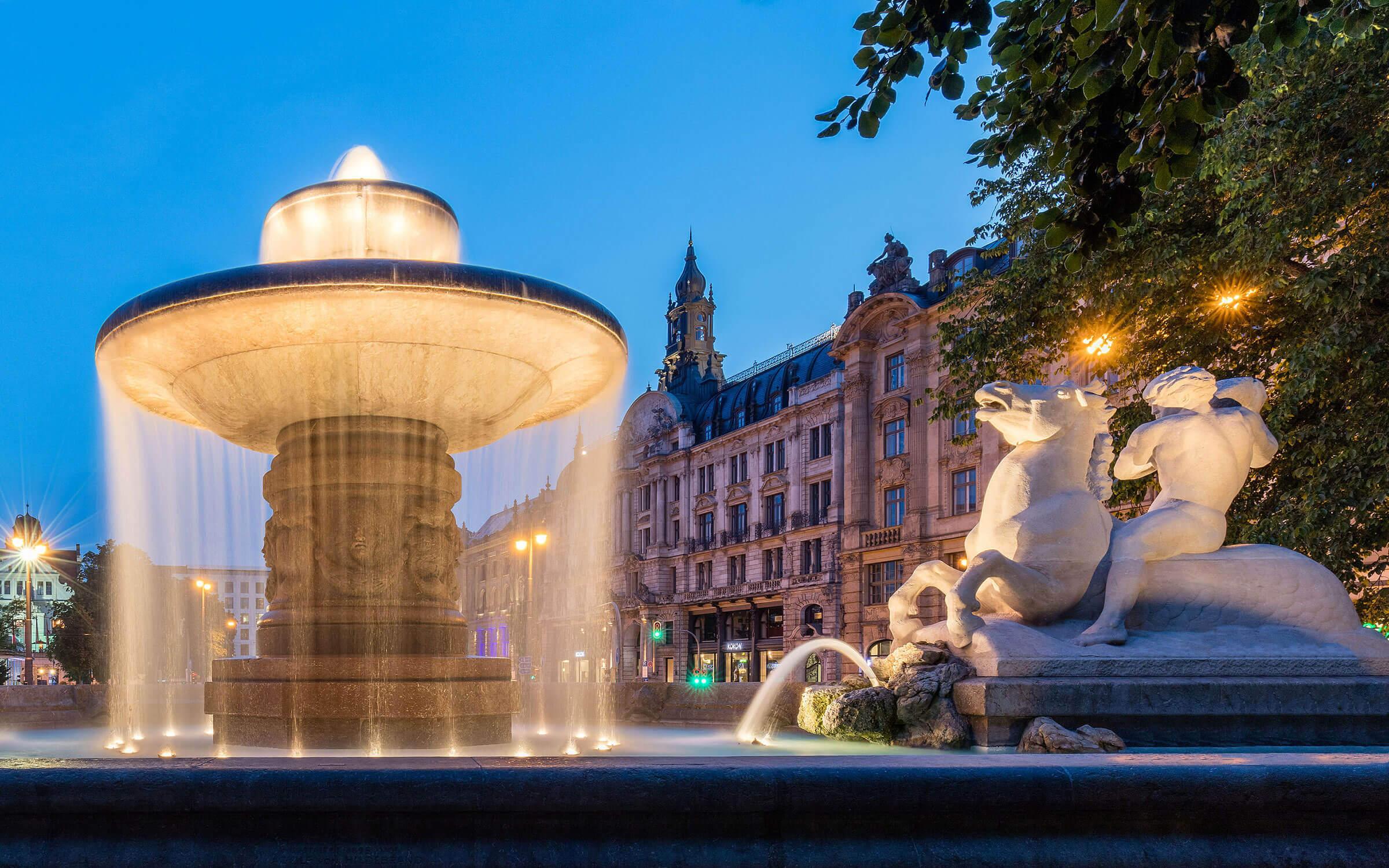The capital of Bavaria is rich in history, culture, and nude sun-bathing (keep reading, I’ll explain). The below cultural touchstones constitute a few of my favourite things to do in Munich, and not just because beer is available at many of them.
5 of Munich’s Must-See Cultural Touchstones

Marking the epicentre of historic Munich, a visit to the New City Hall is a perfect place to start your exploration of town. Commenced in 1867, and built in the Gothic Revival style, the Neues Rathaus is a Gotham City-worthy behemoth replete with gargoyles, dragons and, of course, geraniums. It is also home to Munich’s main tourist information office. For a view of the city, ascend (by elevator) to the 85 m high tower. To catch the ‘Glockenspiel’ (carillon) be in the vicinity at one of four times: 11 a.m., noon or 5 p.m. or 9 p.m.
The Marienplatz, meanwhile, has been Munich’s main square since 1158. The eponymous Marian column in its centre was erected in 1638 to mark the end of Swedish occupation during the 30 Year War. Stand in the centre of the Marienplatz and you are in the centre of Munich.
Larger than both London’s Hyde Park and New York’s Central Park, the English Garden was commissioned at the same time as the French were busy beheading their royalty. Designed by Benjamin Thompson, an American adviser to the government, the park spans 900 acres of shaded paths, ponds, brooks and a smattering of historically inspired follies.
These include a faux Greek temple built in 1838, a Japanese tea house built for the 1972 Olympic Games, and, most famously, the Chinese Tower, a remnant of Europe’s 18th-century obsession with Asia—and now the cornerstone of the city’s oldest beer garden. A shady oasis that serves beer! What more could you ask for? (Other than nude sunbathing, which is not only legal but one of the locals’ favourite pastimes—wilkommen in Deutschland!)

 Art lovers look no further. There is little that cannot be found between these two art world heavyweights. The Old Pinakothek has everything from Rubens to Rembrandt, along with a vast collection of Spanish, Dutch and Italian masters. What makes it unique is its collection of German masters. Alter pieces by Michael Pacher (15th c.) and Lucas Cranach the Elder (16th c.) and numerous works by German Renaissance Painter Albrecht Durer (15th c.). Matthias Grunewald, Albrecht Altdorfer. The list goes on and on.
Art lovers look no further. There is little that cannot be found between these two art world heavyweights. The Old Pinakothek has everything from Rubens to Rembrandt, along with a vast collection of Spanish, Dutch and Italian masters. What makes it unique is its collection of German masters. Alter pieces by Michael Pacher (15th c.) and Lucas Cranach the Elder (16th c.) and numerous works by German Renaissance Painter Albrecht Durer (15th c.). Matthias Grunewald, Albrecht Altdorfer. The list goes on and on.
The Modern Pinakothek is Germany’s largest modern art museum. It houses four different collections: 20th century art, applied design, a graphics collection and an architecture museum—each one capable on its own of creating a great number of blisters on your feet. Besides being world class cultural bastions, the Old and Modern Pinakothek have two other things going for them. They are a one-minute walk apart and both have lovely museum cafes.

Home to the Wittelsbach Dynasty, one of Europe’s longest ruling royal families, their former Munich residence is the town’s primary attraction. Think of all the trappings and treasures you could amass in over 700 years of dynastic rule! This is exactly what you will find at the Residenz Museum. Highlights abound, but don’t miss the beautifully executed, albeit gory, Perseus Fountain and the Antiquarium, the giant hall built to hold the family’s antique collection, itself a marvel of the Renaissance world. Count on two hours to see the highlights.
Need a break from the city? Five kilometres northwest of Munich sits the Wittelsbach’s former summer retreat. (Was its construction due to the royal family having grown tired of sunbathing in the nude with the plebs in the English Garden? Who’s to say?) This sprawling baroque masterpiece has everything you could possibly want to enjoy on a warm summer day. Shaded alleys, enormous basins reaching symmetrically to the horizon, horse stables, trompe l’oeil frescos, as well as the world’s largest collection of German porcelain. Other highlights include a collection of royal coaches and riding paraphernalia fit for kings, including Mad King Ludwig II’s famous rococo ride built for his nocturnal Song of the Nibelungs inspired outings. The current head of the Wittelsbach family, Franz Duke of Bavaria, has an apartment here. Wave if you see him.

 2. Englischer Garten (The English Garden)
2. Englischer Garten (The English Garden)


 Art lovers look no further. There is little that cannot be found between these two art world heavyweights. The Old Pinakothek has everything from Rubens to Rembrandt, along with a vast collection of Spanish, Dutch and Italian masters. What makes it unique is its collection of German masters. Alter pieces by Michael Pacher (15th c.) and Lucas Cranach the Elder (16th c.) and numerous works by German Renaissance Painter Albrecht Durer (15th c.). Matthias Grunewald, Albrecht Altdorfer. The list goes on and on.
Art lovers look no further. There is little that cannot be found between these two art world heavyweights. The Old Pinakothek has everything from Rubens to Rembrandt, along with a vast collection of Spanish, Dutch and Italian masters. What makes it unique is its collection of German masters. Alter pieces by Michael Pacher (15th c.) and Lucas Cranach the Elder (16th c.) and numerous works by German Renaissance Painter Albrecht Durer (15th c.). Matthias Grunewald, Albrecht Altdorfer. The list goes on and on.